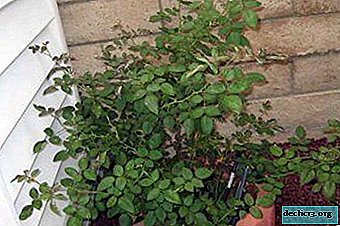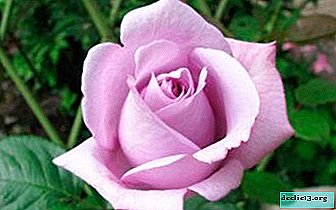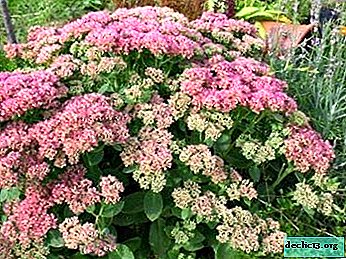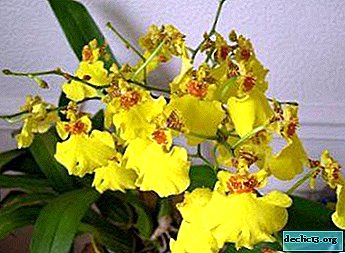Unusual lilac climbing rose Indigoletta: description with photos, planting, flowering, propagation and care

The climbing rose of the Indigoletta variety has a very unusual lilac color for roses and this amazes anyone's imagination.
She can become a real decoration of the garden and solo, and in company with other flowers.
In the article we will tell about the history of origin and features of this variety, and also show a photo. We give detailed instructions for planting, proper care and growing.
Description
Indigoletta is a powerful and vigorous plant. It refers to klimmers (kliming) or, in other words, large-flowered varieties. Its leaves are glossy and have a dark green color. Flowers of lilac color. The bush can grow in height up to 2.5-3 meters, and in width - up to one and a half.
Photo
Here you can see a photo of Indigoletta roses:



History of occurrence
Indigoletta was bred in 1981 by breeder Van de Laak in the Netherlands.
What is the difference from the other varieties?
This rose variety has medium disease resistance. and high winter hardiness. It has a noticeable pleasant aroma. A characteristic difference of the variety is the lilac color of the flowers.
Bloom
When and how?
Flowering Indigoletta repeated, prolonged and plentiful. The buds form a goblet shape and have a dark purple color. The flower itself is a little lighter - lilac-pink, terry. It reaches a diameter of 8-10 centimeters. It is formed by 22-30 petals. During flowering, 203 flowers can be on one peduncle at a time.
Care before and after
During flowering, all faded buds are removed, and in September they trim the plants: partially cut off old and all diseased shoots.
What to do if it does not bloom?
If the rose does not bloom, then there may be several reasons:
 The problem may be in solid, not saturated soil. Therefore, mineral fertilizers should be applied on time. But do not overdo it with nitrogen additives: they just negatively affect the formation of flowers, stimulating the growth of green mass.
The problem may be in solid, not saturated soil. Therefore, mineral fertilizers should be applied on time. But do not overdo it with nitrogen additives: they just negatively affect the formation of flowers, stimulating the growth of green mass.- It is also worth paying attention to whether there is wild growth in the root zone of the plant: it must be removed in a timely manner, otherwise the plant will run wild and, subsequently, will cease to bloom.
- Also, blooms can be affected by diseases and a poorly selected planting site.
Step-by-step instructions for landing and care
- Choosing a landing place. Indigoletta does not like drafts, therefore she will like a windless place. It is better to place it in the shade, since in the bright sun, rose flowers can burn out and acquire a purple hue.
Important. You can also think about creating a shelter for Indigoletta, since rain is contraindicated for her.
- The soil. The soil should be loose and have good drainage.
For a comfortable flower life, it is necessary to regularly loosen the soil and add sawdust. This will help to avoid stagnation of water.
- Landing. It is better to plant roses in September-October.
- Before planting, you need to immerse the rose in water for a couple of hours.
- A hole for the plant needs to be prepared so deep that its roots do not crumple.
- After falling asleep with soil around the plant, it is necessary to form a roller, and then water it. The earthen roller will not allow water to spread.
- After absorbing the fluid, loosen the soil.
In order for the bush to take root well, a sufficient amount of water is needed. Therefore, the first four weeks after planting, it is necessary to water the plant 1-2 times a week, spending a bucket of water. If there is heat, then you can water 3 times a week for 1.5-2 buckets.
 Temperature. This variety has high winter hardiness, and in the summer is unpretentious in relation to air temperature. There is evidence that Indigoletta experienced frost without shelter up to -30 degrees.
Temperature. This variety has high winter hardiness, and in the summer is unpretentious in relation to air temperature. There is evidence that Indigoletta experienced frost without shelter up to -30 degrees.- Watering. Water the rose as needed. If it is transfused, then this can lead to rotting of the roots.
- Top dressing. Fertilizing the climbing rose can be done with manure diluted in water or specialized additives. In summer, you can alternate nitrogenous and complex fertilizers, giving them a rose every three weeks.
- Pruning. Indigoletta is recommended to be cut in early spring. It is necessary to trim a limited number of strong, young and long branches on the bush. A bush with repeated flowering, such as Indigoletta, it is enough to have from 1 to 3 annual shoots of restoration and from 3 to 7 flowering main shoots. It is also necessary to trim too long in comparison with the support of the lash.
- How to tie a plant? You need to tie the rose with very high growth on a support or trellis. When gartering, keep in mind that a horizontally directed shoot blooms more profusely. It is necessary to tie up either with a rigid twine or with a plastic clamp.
Reference. In order for Indigoletta to please with flowers on the lower part of the fence, it must be directed fan-shaped. On the columns, the lashes are twisted in a spiral: it also stimulates flowering.
- Transfer. A plant needs replanting only when it needs to change a bad place. If a transplant is necessary, then it is better to carry it out in September.
- Preparing for the winter. It begins already at the end of summer:
- Stop loosening the ground and watering the plant.
- The bush is wrapped in a tourniquet (or two tows, if it is large enough) and pressed to the ground.
- This should be done gradually, over the course of a week: if the bush does not lend itself, then it is necessary to leave it in a bent position for a day, so that it gets used to the new position, and continue to manipulate later.
- It is necessary to cover the plant with spruce branches and covering material only with the onset of stable frosts, otherwise the bush will ripen and rot.
- The base of the rose is covered with sand or another mulch.
How to propagate?
 This variety of climbing roses is propagated by cuttings. The most affordable option is to use green cuttings. They are received in June. But you can use shoots that remain after spring pruning. The pattern of growing cuttings is the same in both cases.
This variety of climbing roses is propagated by cuttings. The most affordable option is to use green cuttings. They are received in June. But you can use shoots that remain after spring pruning. The pattern of growing cuttings is the same in both cases.
- Cut the cuttings with 2 or 3 nodes. The cut is done at an angle of 45 degrees directly under the lower kidney.
- The leaves on the bottom of the stem are removed.
- The cutlery is planted in a container with a mixture of earth and sand to a depth of 1 centimeter.
- Then they cover the plant with film or glass containers and shade from the sun. Water the sprout without removing the film.
Diseases and pests in relation to this species
- Although Indigoletta has an average resistance to powdery mildew, in adverse times, it can still become ill with it. You can notice this scourge by a gray coating on the leaves, which over time becomes more dense, gradually forming a black fungus. The leaves of the affected bush dry out, and the buds dry out prematurely.
Excessive humidity can cause this fungus. You can deal with it by spraying with copper sulfate in the spring, and in the summer with soda ash and soap. It is also necessary to cut out all the affected shoots, to rake and burn all the fallen leaves.
- Black spotting is another of the diseases that Indigoletta is susceptible to. A bush can get sick at a favorable time for this adversity: in rains at a moderately warm air temperature. Brown or black spots with a yellow canvas appear on the leaves. To prevent this disease, it is necessary to water the plant only under the root and in time to rake all the fallen leaves. In summer, when spots appear, you need to spray the bush with Bordeaux liquid.
Caring for Indigoletta is simple, even if it is not the most unpretentious plant. You can decorate the garden with a rose, wrapping it around arches, columns or planting along the fence. And the pleasant aroma of the bush will be an additional bonus to the charming beauty.

 The problem may be in solid, not saturated soil. Therefore, mineral fertilizers should be applied on time. But do not overdo it with nitrogen additives: they just negatively affect the formation of flowers, stimulating the growth of green mass.
The problem may be in solid, not saturated soil. Therefore, mineral fertilizers should be applied on time. But do not overdo it with nitrogen additives: they just negatively affect the formation of flowers, stimulating the growth of green mass. Temperature. This variety has high winter hardiness, and in the summer is unpretentious in relation to air temperature. There is evidence that Indigoletta experienced frost without shelter up to -30 degrees.
Temperature. This variety has high winter hardiness, and in the summer is unpretentious in relation to air temperature. There is evidence that Indigoletta experienced frost without shelter up to -30 degrees.














